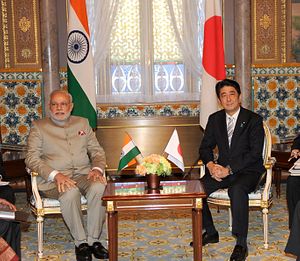Japanese Prime Minister Shinzo Abe met with Indian Prime Minister Narendra Modi on December 12. As Abe concluded his short two-day visit to India the end of their meeting, the two leaders issued Japan-India Vision 2025 Special Strategic and Global Partnership. In this document, Abe and Modi agreed on expanding bilateral cooperation in a wide range of issues from investment, disaster risk management, and people-to-people exchange. They also acknowledged that stability of the Indo-Pacific region to be “indispensable” to their respective national security and prosperity, calling for a more robust cooperation in security issues.
The Japan-India relationship is among the core relationships that Abe has focused on since he served prime minister for the first time, from 2006-2007. In fact, shortly after Abe returned to power in December 2012, he contributed an important commentary to Project Syndicate on December 27, 2012. In this commentary, he introduced the “Diamond Concept (daiyamondo kousou), in which he envisioned that the United States, Japan, Australia, and India would form a virtual security “diamond” and work together to maintain the peace and stability of the Indo-Pacific region.
This commentary by Abe attracted hardly any attention in Japan when it was published. However, when reflecting on the major foreign policy decisions that Abe has made since then, it is clear that Abe’s moves to pursue more robust relationships with Australia and India, while continuing to anchor these relationships with its alliance with the United States, are remarkably consistent with this “Diamond Concept.” It is also a critical component of his government “proactive contribution to peace” principle articulated in the National Security Strategy.
This weekend, as the two leaders agreed to elevate their bilateral relationship to “special strategic and global partnership,” the Japanese and Indian government signed two important security agreements.
One is a Japan-India agreement on defense equipment and technology transfer. With elements such as the establishment of a Japan-India Joint Committee for the oversight and prohibition of third-party transfers without prior approval, this agreement paves the way for a more robust Japan-India cooperation in the area of defense technology.
The other is the Agreement Concerning the Security Measures for the Protection of Classified Military Information. Commonly referred to as the general security of military information agreement (GSOMIA), this agreement obligates both Japan and India to protect classified military information exchanged between the two countries, thereby facilitating more robust intelligence exchanges between the Indian Armed Forces and the Japan Self-Defense Force (JSDF). That, in turn, creates a foundation for a more robust defense cooperation between the two.
These agreements build on the progress in Japan-India bilateral defense relations, which was jump-started when Abe visited India in August 2007 during his first stint as prime minister. Since then, the deepening of Japan-India relations, along with Japan-Australia relations, has enjoyed bipartisan support in Japan. Indeed, it was under Democratic Party of Japan (DPJ) rule that Japan and India signed two critical documents that serve as the stepping stoned of today’s relationship — the Joint Declaration on Security Cooperation between Japan and India in October 2008, and the Action Plan in December 2009 to implement what was agreed upon in the Joint Declaration on Security. In 2013, the leaders of the two countries signed an agreement in which the both sides agreed to allow the Indian Navy and Japan Maritime Self Defense Force (JMSDF) to hold joint training on a regular basis. JMSDF also has already participated in the U.S.-India bilateral exercise Malabar as an observer. Now that the agreements on defense technology transfer and GSOMIA both in place, Japan-India security relations have become one of Japan’s most institutionalized relationships, only after security ties with the United States and Australia.
Similar to its security partnership with Australia, Japan’s security cooperation with India allows Japan to engage one of the biggest security partners for the United States on a host of security issues. A close security partnership with Australia has afforded Japan the opportunity to be more active in areas, such as capacity building in Southeast Asia and the Pacific Islands, that are critical for the stability of the Asia-Pacific region. A closer security relationship with India benefits Japan in a similar way. With a solid institutional framework in place, it is up to the defense leaders in Tokyo to optimize this framework and achieve a concrete result, thereby adding real meat to the bones of this growing relationship.

































